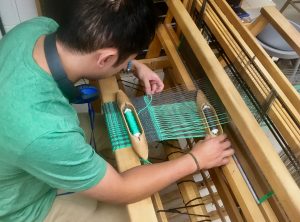This week has been a whirlwind of learning. It is amazing to work our way through the many steps of creating fabric—something we are in contact with every day. Textiles are such an integral part of cultures all over the world and the craft of weaving is a specialized and versatile one. Somehow handling the yarn, the loom, and the books of hundreds of patterns holds a weight of an ancient and beloved art. Fabrics such as quilts are passed down as special heirloom items through generations. Epic stories of empires are recorded in fabric for us to see today in the form of tapestries. The more I learn each day, the more I am amazed at how vast and deep the world of fiber arts really is and the more sure I am that we have endless amounts to learn. In only one week we have already learned to thread a loom, weave a few twill variations, dye wool, and read patterns yet here we are at the tip of the iceberg!
The loom turns out to be a very complex mechanism. Any slight mishaps that might occur in setting up will become clear in the woven piece. Careful method becomes crucial in preventing utter madness.

With the yarn that each of us dyed to our desired color (or an accidental other color) we set up for our four different Twill samples. It was amazing to see the patterns emerge as we wove! The sounds of everyone weaving at once are very satisfying. The squeaking and clacking of the wood looms, the whooshing of the beater against fiber, and the occasional gasp of dismay make for an eclectic orchestra. When all of our samples were done, including our exploratory handloom pieces, we pinned them to the gallery wall and beheld our work as a class. What an enlightening week it has been.